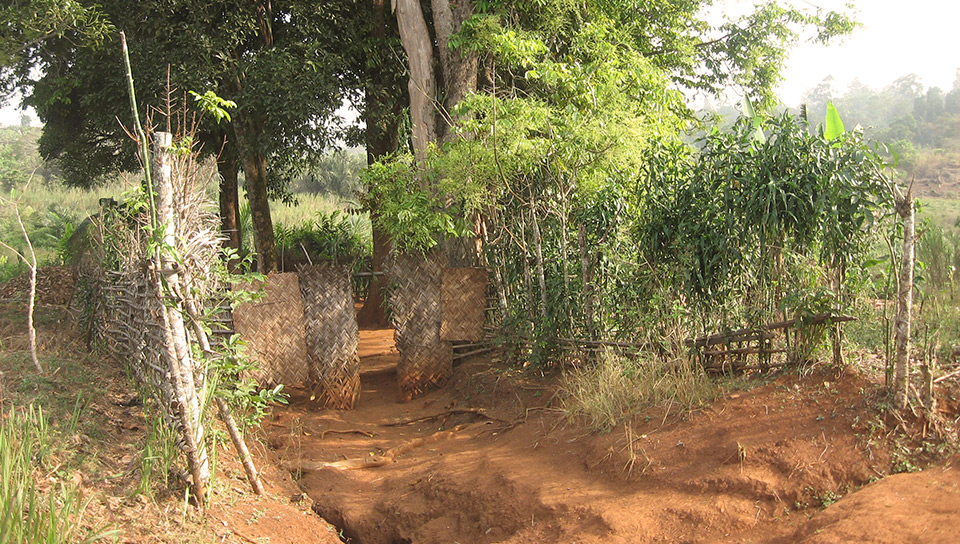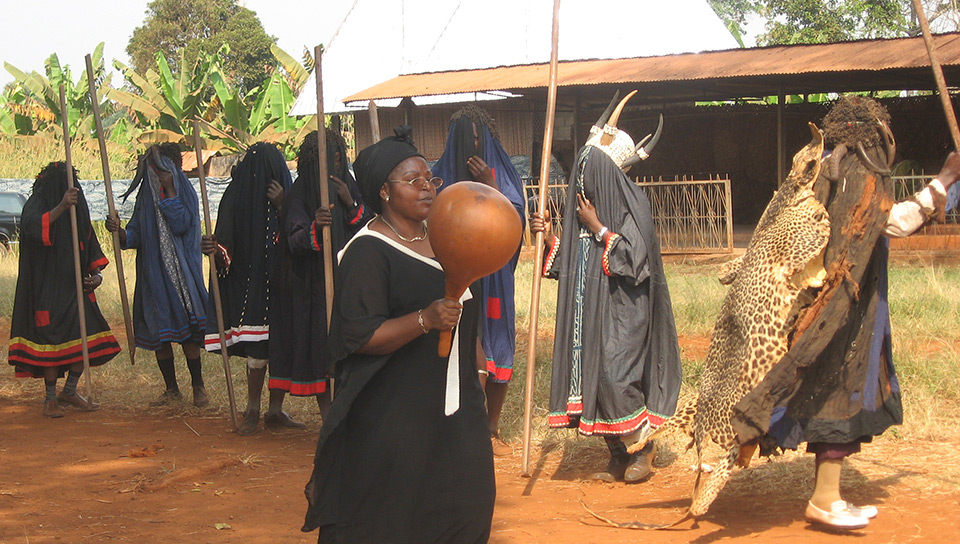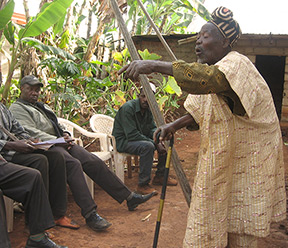I Bandjoun område i det vestlige Cameroun ligger forskellige steder opfattes som helligt af de lokale folk. They are the remnant cores of sites that were historically a lot more extensive representing the identity of tribes and communities in the region. The character of separate sites differs in terms of function and the social group that makes use of it. Two examples are family shrines, usually with presence of a fig tree (Ficus sp.), and community gathering places which constitute centres of traditional initiations to the community life. Den delte funktion de fleste steder er tilbedelse af guderne. Selvom økologi disse hellige naturområder har fået lidt opmærksomhed til dato, de er kendt for havnen dyr og planter, som er stort set forsvundet fra de omkringliggende områder.
Trusler
Traditional leaders stated that the survival of sacred areas is not threatened because these areas are strongly linked with the community identity. Nevertheless they worry about the changing attitude of young people who are becoming increasingly materialistic and disobey taboos and show lest respect for ancestral beliefs. I dag, mange mennesker bruger hellige områder uden at informere deres kontoførende, angiver udhuling af kulturelle normer. Mere vigtigste trusler er blevet identificeret, endnu mest er under debat blandt de lokale folk selv.
Infrastructure development, especially road construction and urban settlement, has caused the degradation of sacred areas in Bandjoun. The expansion of Christianity offers alternative views on the need for protection and honesty. Some Christian priests are said to have a diabolic view on the sacred sites. According to some local traditional spiritual leaders the fact that for Christian’s punishment of wrong deeds comes after death, while for local beliefs punishment takes immediate effect increases people’s disobedience of the ancestral beliefs and taboos.
Dog, a decreasing influence of Christianity on local beliefs is also reported as well as an increasing willingness of Christian priests to listen to locals and work on an interfaith understanding. According to some, even modern education can have a negative impact on traditional beliefs, due to the decreasing time children spend with their parents. Derudover, the changing lifestyles cause a decreased interest in traditional values putting the continued care for these sacred natural sites at risk.
Depotinstitutioner
Gennem århundreder, de Bandjoun mennesker har udviklet en nedarvet styringssystem hellige naturområder. Placeringen af naturlige og delvis naturlige hellige steder er identificeret af de igangsatte åndelige ledere (MkamSi, Guèkè). Mens de fleste har været veletablerede, the location of a sacred area is not immutable and can be changed for reasons like road construction or socio-political reorientation. Generelt, hvert helligt område kommer under ansvar af en depotbank kaldet Nongtchuép. Han er ansvarlig for at gøre tilbud og ofre, som han kan også bemyndige en repræsentant. These are initiated elders who are universal custodians. De har ret til at arbejde i alle tilbedelse sites.
Even though women are generally regarded as heaving little to do with sacred areas, deeper investigation revealed that their role is present, but hidden and ignored. For eksempel, Megnesi (female equivalent of MkamSi) have the same capacities and duties as their male counterparts. Only the mothers of initiated twins can clean certain sacred sites. A woman can substitute the family chief and make offerings and sacrifices at a sacred place. Endvidere, the traditional education is primarily given by women who enforce conservation regulations for sacred areas.
Conservation Værktøj
De følgende værktøjer til bevaring er blevet fastlagt hidtil:
- En liste over foranstaltninger for at tage næste
- En liste over de berørte parter
- Opgørelser af de traditionelle ledere
- Samfundsfag, der indeholder de lokale folks syn på situationen
- Participatoriske kort over de hellige naturområder i regionen
Vision
De største fremskridt støtter bevarelsen af hellige områder vil være deres juridiske anerkendelse, øget offentlig opmærksomhed, reducerede negative ændringer i arealanvendelsen og en bedre anerkendelse af deres socio-kulturelle og økologiske betydning. For at opnå alle de ovennævnte vil kræve inddragelse af interessenter på lokalt, nationalt og internationalt plan.
Coalition
Effective and appropriate support is needed for further conservation of these sites. As a possible solution, Bandjoun community members suggest that involving stakeholders like women, young people, NGO'er, religious institutions and maybe even state institutions to develop management in sacred areas in a participatory way whilst clearly agreeing on the role of each stakeholder.
Action
Lille indsats er i øjeblikket gennemføres, bortset fra nogle få undersøgelser, bevidstgørelse af Bandjoun folk, at deres hellige steder er på spil. Den Banjoun kræver støtte for at identificere truede hellige naturområder er vigtige for lokalsamfundene. De vil gerne gøre en klar afgrænsning af dem, og at udvikle en passende strategi for en bæredygtig forvaltning af.
Politik og Jura
De hellige naturområder på dette område er i øjeblikket ikke anerkendes retligt. Samlet skovforvaltning er den bekymring af Ministeriet for skove og vilde dyr i henhold camerounske juridiske statuer.
Som et resultat af en social undersøgelse, øget bevidsthed om Bandjoun folk er det vigtigste resultat hidtil. Det er en udbredt opfattelse, at indblanding fra statens side i forvaltningen af hellige naturområder kunne udgøre risici og generere konflikt. Regeringsembedsmænd mistænkes for at have til passende ressourcer, til hensigt at svække styrken af de ældste. EU-medlemmer foreslår bevidstgørelse af offentligheden, kortlægge og afgrænse grænserne for de hellige områder, forbedring af kendskabet til, stakeholders working together and devolving power of the government could all be good solutions to stop the worsening situation.
- Kamga-Kamdem S L., (2010) Ancestral Beliefs and Conservation. The case of sacred natural sites in Banjoun, west Cameroon, i Verschuuren, B., Wild R., McNeeley, J. og Oviedo., G. (Eds.) Sacred naturområder, Bevaring af Natur og Kultur, Earth Scan, London,.pp. 119-128.






